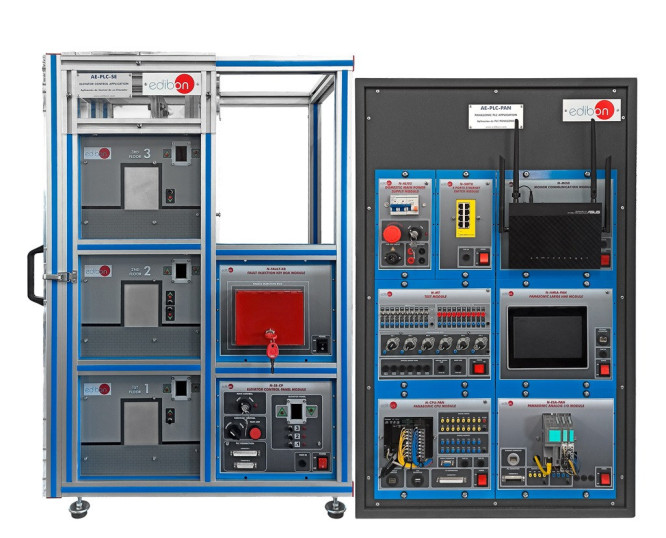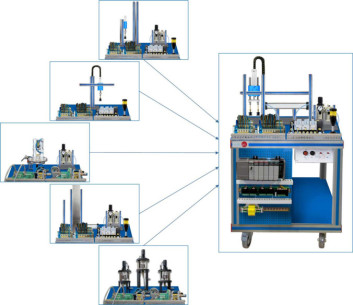L'Application de Contrôle d'Ascenseur, "AE-PLC-SE", a été conçue par EDIBON avec un double objectif. D'une part, cette application permet d'étudier les principaux composants électromécaniques qui intègrent aujourd'hui tout ascenseur. Les plus importants sont les capteurs de position, les moteurs électriques pour déplacer l'ascenseur et la porte coulissante, les fins de course, le contrepoids, les identifiants numériques d'étage, les boutons d'appel, entre autres mécanismes. D'autre part, tous ces capteurs et actionneurs mentionnés ci-dessus nécessitent un automate programmable (PLC) qui nous permet de contrôler l'ascenseur de manière efficace et sûre. Programmer un automate pour contrôler un ascenseur est un défi de taille pour tout étudiant en formation professionnelle ou en ingénierie cherchant à renforcer ses connaissances dans le domaine de l'automatisation industrielle. C'est pourquoi l'application "AE-PLC-SE" est un outil d'apprentissage extrêmement utile pour l'automatisation des API.
Le "AE-PLC-SE" est un ascenseur construit sur mesure qui peut être entièrement automatisé. Il comprend une structure en aluminium qui forme le squelette de l'ascenseur subdivisé en trois niveaux ou étages. À l’intérieur de la structure se trouve un rail ou guide vertical par lequel l’ascenseur glisse entre les trois étages. Ce rail est doté d'un moteur à courant continu au sommet, à l'axe duquel est couplée une chaîne transporteuse qui transforme le mouvement rotatif du moteur en un mouvement linéaire. Cela permet de contrôler à tout moment le déplacement linéaire de l'ascenseur. Chaque étage de la structure dispose de boutons d'appel ainsi que d'indicateurs de la position actuelle de la voiture. De plus, il comprend un panneau de commande qui représente l’intérieur de la cabine d’ascenseur. Depuis ce panneau, deux modes de fonctionnement peuvent être sélectionnés (automatique ou manuel) ainsi que l'envoi de l'ascenseur aux différents étages au moyen de trois boutons-poussoirs qui représentent les commandes à l'intérieur de l'ascenseur. Il comprend également un module d'injection de défauts qui permet d'injecter des défauts de manière contrôlée dans l'application dans le but d'apprendre à identifier les problèmes les plus fréquents pouvant survenir dans les mécanismes/ signaux de l'ascenseur.
La cabine d'ascenseur comprend trois plaques d'aluminium (niveau supérieur, moyen et inférieur) qui permettent de localiser précisément sa position. A cet effet, chaque étage dispose d'un capteur capacitif capable de détecter ces plaques. De cette manière, il est possible de programmer des fonctions d'approche au sol, avec accélération et décélération. des rampes qui permettront un contrôle en douceur de la réponse du moteur de la voiture une fois l'étage souhaité atteint. Dans le cas où l'ascenseur n'est détecté par aucun capteur parce que, par exemple, il s'est arrêté entre deux étages et donc la position exacte n'est pas connue, il est possible de programmer une fonction d'alignement automatique qui place l'ascenseur dans une position de référence. Deux capteurs de fin de course aux deux extrémités du rail sont également inclus comme protection supplémentaire pour arrêter le moteur.
La porte de l'ascenseur est contrôlée par un moteur à CC et deux capteurs de fin de course. Ces capteurs détectent quand la porte est complètement ouverte ou complètement fermée. De cette manière, il est possible de programmer le contrôle du moteur qui entraîne le mouvement de la porte. De plus, à l'intérieur de la cabine se trouve un capteur de barrière capable de détecter l'interposition d'un objet lors de la fermeture de la porte, comme cela se produit dans les vraies portes d'ascenseur.
Cette application offre de multiples possibilités lors de la programmation des conditions qui contrôleront le fonctionnement de l'ascenseur. C'est ici que les critères et les compétences de chaque programmeur détermineront ces conditions même si, pour faciliter la compréhension de la programmation de ce système, EDIBON propose une série de programmes qui peuvent être utilisés comme exemples.
 Préférences sur les cookies
Préférences sur les cookies







